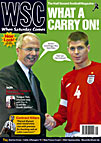 As the divisions change names again, Tom Davies listened to those championing the Championship and came away unimpressed
As the divisions change names again, Tom Davies listened to those championing the Championship and came away unimpressed
S o goodbye Nationwide League Divisions One, Two and Three, hello Coca-Cola Championship and Leagues One and Two. The Football League’s name changes have attracted so much ridicule that to deride them already feels too much like indulging in a fish-in-a-barrel shooting contest.
The League themselves, though, are sufficiently serious about it to have called the media to a Westminster press conference late last month so that chairman Sir Brian Mawhinney could explain the rebranding and other marketing plans. The League hasn’t “reviewed its public perception” for 15 years, see, and it was time, apparently, that this was redressed.
So we have a new logo, one that has met with widespread acclaim (phew!) and a fresh emphasis on community relations and commercial development. And, of course, the Championship. This was not a gimmick, said Mawhinney, but a reconnection to the game’s history. The original and still-existent trophy bears the imprint “Football League championship”, so it was in keeping with that heritage, we were assured, that the renaming had come about. The assembled journalists were even invited to take a moment to study the trophy on the way out (We did. It looks nice. Will this do?).
The retitling of the bottom two divisions as Leagues One and Two is the inevitable follow-on from this, which was justified in a flurry of buzzwords about “repositioning the Football League to make it more attractive” and becoming “a commercial partner of choice for big companies”. In any case, Mawhinney argued, “Three weeks into the season, absolutely nobody’s going to care whether it’s called League Two or Division Three.” Which all rather begs the question, why bother with such a misleading name change in the first place? League Two, whatever way you slice it, is still the Fourth Division. Marketing mumbo-jumbo may be able to mislead and obfuscate; football results do not.
A whole host of promotional wheezes are planned, one being the introduction – when sponsorship permits – of a “fans’ league”, to reward supporters for relative levels of vocal support at each match. “Fan-focused” rewards for divisional winners will follow at the end of the season. The words “can” and “worms” immediately spring to mind here: will fans whose best vocal efforts are aimed exclusively at the alleged sexual proclivities of a rival manager still romp to victory? Or will the competition reward only those supporters prepared to sing with all the innocence of a crowd in a Roy of the Rovers strip? They might better capture the spirit of your average lower-division crowd by doling out points for “sack the board” chants and the inexplicable scapegoating of new signings. However it operates, it all sounds horribly patronising.
It’s easy to mock the League, though. We’re not talking about the G-14 here, or any of football’s large cast of bona fide wrong ’uns. It is in the interests of the game as a whole that the League thrives. They have found themselves facing innumerable financial and organisational challenges in recent years, often caused by circumstances beyond their control. And they have indeed set a benchmark in introducing measures such as fit-and-proper-person tests for club owners, registration of agents’ fees, ten-point penalties for clubs that go into administration and the extension of salary-capping to League One as well as Two (questionable though the desirability of these last two are). FIFA’s threat to prevent Football League clubs from trading with each other outside transfer windows from the beginning of next season poses further problems.
The League’s desire to deal with all these issues is sincere, but in placing so much stress on marketing and PR they risk underplaying existing selling points – crowds at a 40-year high, relative ease of admission, a level of fan commitment unsurpassed worldwide – in pursuit of a market position they can never attain. They aren’t the Premiership. Their leading clubs don’t want to play in it. No one can retain the Championship (and may this always be the case), which makes targets such as the League’s aim for seasonal attendances of 21 million by 2010 such an unreliable one.
Hanging over all this is the yawning gap between the Premiership and the rest, which the league is more than ready to acknowledge but less prepared to challenge. “In the last 18 months I haven’t said a critical word about the FA or the Premiership,” Mawhinney boasted. There is a reluctance here to reverse the redistributive imbalance between rich and poor in the game (and the “r” word isn’t a word that falls easily from New Labour lips, let alone those of an old Tory warrior such as Mawhinney, even though he too argues that the current imbalance is bad for the game). So all the natty logos, market profiles and rebranding are all so much rearranging of the deckchairs on the Titanic. Except this Titanic need not, and almost certainly will not, actually sink.
From WSC 211 September 2004. What was happening this month